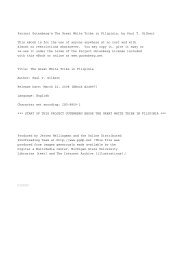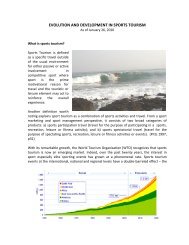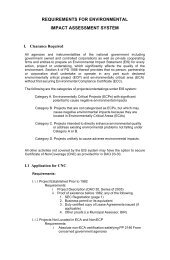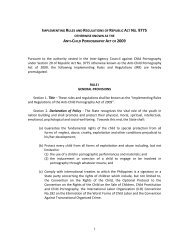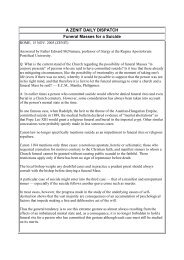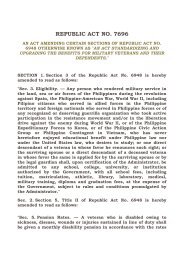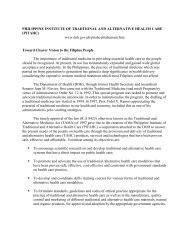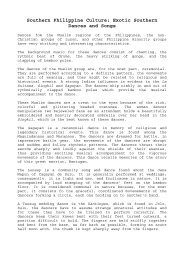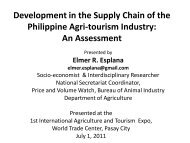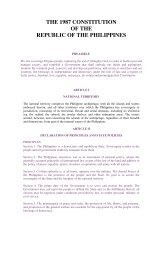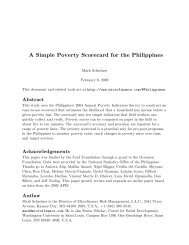Mining in the Philippines - Concerns and Conflicts
Mining in the Philippines - Concerns and Conflicts
Mining in the Philippines - Concerns and Conflicts
You also want an ePaper? Increase the reach of your titles
YUMPU automatically turns print PDFs into web optimized ePapers that Google loves.
Appendix 5. The Threat to Indigenous Rights <strong>and</strong> Environment by <strong>M<strong>in</strong><strong>in</strong>g</strong><br />
- A Philipp<strong>in</strong>e Case Study<br />
A Letter of His Excellency<br />
MOST REV. RAMON B. VILLENA, D.D.<br />
Bishop's Residence Bishop of Bayombong,<br />
Bayombong, 3700 Nueva Vizcaya<br />
Thursday, 21 September 2006<br />
Latest government statistics on national physical accounts show that m<strong>in</strong><strong>in</strong>g <strong>in</strong> <strong>the</strong> Philipp<strong>in</strong>es has ga<strong>in</strong>ed <strong>in</strong><br />
value. However <strong>the</strong> environmental degradation it has caused has also <strong>in</strong>creased. This, it seems, is <strong>the</strong> pr<strong>in</strong>cipal<br />
trigger of <strong>the</strong> cont<strong>in</strong>u<strong>in</strong>g wide opposition aga<strong>in</strong>st m<strong>in</strong><strong>in</strong>g as an economic activity <strong>in</strong> <strong>the</strong> country. Placed fur<strong>the</strong>r<br />
<strong>in</strong> <strong>the</strong> context of extremely high biodiversity, low l<strong>and</strong> base, ris<strong>in</strong>g dem<strong>and</strong> for l<strong>and</strong> due to a ris<strong>in</strong>g population,<br />
extremely socially sensitive tenure regimes <strong>in</strong>volv<strong>in</strong>g <strong>in</strong>digenous peoples, <strong>and</strong> high downstream impacts of<br />
open extraction <strong>in</strong> a generally mounta<strong>in</strong>ous archipelago, <strong>the</strong> negative externalities of m<strong>in</strong><strong>in</strong>g <strong>in</strong>vite magnified<br />
cause for social, ethical, religious <strong>and</strong> ecological concerns.<br />
International m<strong>in</strong><strong>in</strong>g companies from Australia (n<strong>in</strong>e at <strong>the</strong> last count) have entered <strong>in</strong>to f<strong>in</strong>ancial <strong>and</strong> technical<br />
assistance agreements. Climax Arimco <strong>M<strong>in</strong><strong>in</strong>g</strong> Corp. (CAMC), whose name has been changed to Australasian<br />
Philipp<strong>in</strong>es <strong>M<strong>in</strong><strong>in</strong>g</strong> Inc. (APMI) operates on 21,465 hectares of <strong>the</strong> Didipio Copper/Gold Project <strong>in</strong> Didipio,<br />
Kasibu, Nueva Vizcaya. The site is located some 200 km north of Manila.<br />
The company claims that it has "strong local community <strong>and</strong> government support." This could not be far<strong>the</strong>r<br />
from <strong>the</strong> truth. The people have resisted <strong>the</strong> entry of <strong>the</strong> m<strong>in</strong>e from <strong>the</strong> beg<strong>in</strong>n<strong>in</strong>g of <strong>the</strong> mid 1990s. Here are<br />
some events:<br />
1. Invok<strong>in</strong>g a people's <strong>in</strong>itiative, <strong>the</strong> local barangay mustered 20% of <strong>the</strong> legitimate voters <strong>and</strong> filed a petition to<br />
<strong>the</strong> Commission on Election (COMELEC) for <strong>the</strong> conduct of a referendum to decide whe<strong>the</strong>r <strong>the</strong> m<strong>in</strong>e should be<br />
allowed <strong>in</strong> or not. However, <strong>the</strong> COMELEC took almost four years to act on <strong>the</strong> petition. Eventually, <strong>the</strong><br />
petition became moot <strong>and</strong> academic s<strong>in</strong>ce <strong>the</strong> majority of <strong>the</strong> anti-m<strong>in</strong><strong>in</strong>g c<strong>and</strong>idates for <strong>the</strong> Sangguniang<br />
Barangay (local legislative body) won 6 out of 8 seats. The people retracted <strong>the</strong>ir petition for obvious reasons.<br />
2. The local barangay council (Didipio) had passed a resolution approv<strong>in</strong>g <strong>the</strong> m<strong>in</strong>e's entry, which was revoked<br />
by <strong>the</strong> new set of barangay officials after <strong>the</strong> 2004 election. (The officials were reportedly elected on <strong>the</strong> basis of<br />
<strong>the</strong>ir anti-Climax Arimco st<strong>and</strong>.)<br />
3. In July 2005, <strong>the</strong> municipality of Kasibu voted aga<strong>in</strong>st <strong>the</strong> entry of <strong>the</strong> m<strong>in</strong>e, but <strong>the</strong> prov<strong>in</strong>cial government<br />
(egged on by <strong>the</strong> regional MGB) approved it <strong>the</strong> follow<strong>in</strong>g month.<br />
4. With<strong>in</strong> a week of <strong>the</strong> prov<strong>in</strong>cial board's decision, <strong>the</strong> people – led by DESAMA (Didipio Earth Savers<br />
Movement) <strong>and</strong> supported by <strong>the</strong> Social Action Centre of <strong>the</strong> Diocese of Bayombong, Nueva Vizcaya – turned<br />
out <strong>in</strong> a well-attended <strong>in</strong>dignation rally <strong>in</strong> front of <strong>the</strong> prov<strong>in</strong>cial capitol. Despite <strong>the</strong> ra<strong>in</strong>s <strong>and</strong> <strong>the</strong> short notice,<br />
some 1,000 people were at <strong>the</strong> rally.<br />
The local economy is agricultural, with fruits, vegetables, <strong>and</strong> rice grown <strong>in</strong> <strong>the</strong> prov<strong>in</strong>ce <strong>and</strong> brought for sale to<br />
Manila. There is also a thriv<strong>in</strong>g citrus fruit production, for which a festival is held every two years, to announce<br />
to all that "<strong>the</strong> people’s gold is picked from a tree, not dug from <strong>the</strong> ground." (Their situation is much like that<br />
of Tambogr<strong>and</strong>e, Peru, where farmers engaged <strong>in</strong> grow<strong>in</strong>g lemons <strong>and</strong> mangoes fought a giant gold m<strong>in</strong>e.)<br />
Brooms <strong>and</strong> baskets woven by <strong>the</strong> people from locally-sourced plants are also brought to Manila or sold along<br />
<strong>the</strong> highway.<br />
The people are a mixture of Ilocano <strong>and</strong> several <strong>in</strong>digenous tribes, notably <strong>the</strong> <strong>in</strong>digenous Bugkalot (or Ilongot)<br />
<strong>and</strong> <strong>the</strong> Ifugao, who went east when <strong>the</strong> large dams <strong>in</strong> <strong>the</strong> Cordilleras displaced <strong>the</strong>m <strong>in</strong> <strong>the</strong> 1960s <strong>and</strong> 1970s.<br />
The people resist <strong>the</strong> m<strong>in</strong>e because:<br />
41



